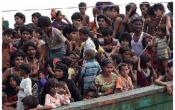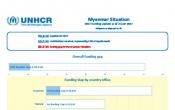Myanmar
Operation: Myanmar
Location
Latest update of camps and office locations 21 Nov 2016. By clicking on the icons on the map, additional information is displayed.
Key Figures
| 2016 end-year results | |
| 50,000 | IDPs received shelter support |
| 5,360 | people of concern participated in SGBV prevention and response awareness activities |
| 320 | people of concern from different backgrounds participated in projects aimed at promoting peaceful co-existence |
| 316 | government officials received training on citizenship and birth registration standards and good practices |
| 120 | return assessments were conducted in 53 vilages across the south-east of Myanmar through which 965 spontaneous refugee returnees and 1,859 IDP returnees were identified |
| 71 | refugees returned from the camps in Thailand to Myanmar, facilitated by UNHCR and the Governments of Myanmar and Thailand |
| 2017 planning figures | |
| 185,000 | IDPs will benefit from camp coordination and camp management support |
| 25,000 | IDP and refugee returnees will be assisted with civil status registration or documentation in the south-east of Myanmar |
| 6,500 | internally displaced households will receive shelter support |
| 700 | protection monitoring visits will be conducted in Rakhine State, Kachin State and northern Shan State |
| 450 | government officials will be trained on citizenship and birth registration standards and good practices |
| 20 | advocacy interventions on international standards for the protection of stateless persons will be conducted |
Latest Updates and Related Links
People of Concern
2016
| 2016 | 1,302,375 |
| 2015 | 1,414,357 |
| 2014 | 1,186,501 |

Myanmar
- 2014
- 2015
- 2016
- 2017
Working environment
The formation of the new democratically elected government in April 2016, represented an important step in Myanmar’s democratic transition. However, the new Government faces enormous challenges in moving the national reconciliation process forward, strengthening respect for human rights, protecting civilians in armed conflict, improving the conditions in Rakhine State and addressing some of the country’s deeply rooted divisions along ethnic and religious lines.In the south-east of Myanmar, the large scale return of internally displaced people (IDPs) and refugees residing in Thailand was not yet achieved in 2016 and only small numbers returned. In addition, clashes in Kayin State between the security forces and a splinter group in September exposed the fragile nature of Myanmar’s peace process.
In the north-eastern part of the country, fighting between the military and ethnic armed groups intensified towards the end of the year, displacing thousands of civilians and making the prospects of durable solutions for those in protracted displacement more elusive than ever.
In Rakhine State, where the majority of the stateless population lives, promising initiatives to address sectarian tensions took place with the establishment by the new government of two committees: the Central Committee on Implementation of Peace, Stability and Development of Rakhine state in May, chaired by Aung San Suu Kyi; and the Advisory Commission on Rakhine State in August, chaired by former UN Secretary General Kofi Annan.
The situation deteriorated significantly in October 2016 when attacks by armed individuals against three border posts led to a lockdown and counter-insurgency operations by Myanmar security forces in the three northern townships of the state. By the end of 2016, these operations had forced some 43,000 stateless Muslims to flee to Bangladesh and displaced an estimated 30,000 within Maungdaw district.
Population trends
Total estimated population of concern for UNHCR is 1.3 million, including 926,000 Stateless people and 375,000 internally displaced people (IDPs).Achievements and impact
- UNHCR continued to address the most pressing humanitarian needs, to monitor the protection environment and to engage in strategic advocacy to mobilize actors to place protection and solutions at the center of their action.
- For the two IDP situations in Rakhine and Kachin / northern Shan States, UNHCR upheld its responsibilities within the inter-agency humanitarian response and assumed both coordination and operational delivery role in the areas of protection, shelter, non-food items (NFIs) and camp coordination camp management. A key focus in 2016 was to support and strengthen the capacities of the Rakhine State Government to reform camp management committees (CMCs) in IDP camps and to initiate the camp profiling exercise. In addition to ensuring cluster leadership and coordination, UNHCR provided substantial financial and technical support in the area of Protection, Shelter, NFI and CCCM, benefitting 100,000 individuals.
- On Statelessness, UNHCR continued its capacity building and advocacy efforts mobilizing support and advocacy within the UN and diplomatic corps to prevent further deterioration in the protection environment.
- In the south-eastern border areas, UNHCR supported the first facilitated and monitored return of 71 refugees from Thailand to Myanmar. While the number of returnees was smaller than anticipated, this represented a major landmark, symbolized the incremental expansion of protection space and provided an opportunity to establish a mechanism and learn lessons for future returns. UNHCR also conducted multi-stakeholder return and reintegration workshops, during which UN Agencies, government, NGOs and ethnic armed groups openly discussed complex protection issues and reintegration challenges. While encouraging the involvement of early recovery and development actors to the return areas, UNHCR re-oriented its engagement strategy to focus on key protection areas: return assessments and monitoring, civil documentation, birth registration, community mobilization and livelihood activities aimed at peaceful coexistence.
- Overall, UNHCR delivered on protection monitoring; drove the protection analyses to influence greater protection coherence throughout the humanitarian and development response; provided targeted assistance through shelter, NFIs, CCCM as well as assistance to persons with specific needs and continued addressing protection concerns arising from displacement and statelessness.
Unmet needs
Due to funding constraints, UNHCR was not able to cover all needs for shelter construction and repair, including for the renovation of temporary shelters built in 2013. By the end of 2016, over 86,000 IDPs were in need of shelter repair of construction.
The changing political and operational contexts in Myanmar continue to affect the lives of people of concern. In addition, the general election in November 2015 and ensuing political landscape are expected to further affect UNHCR’s operations and populations of concern.
For the stateless population and internally displaced people (IDPs) in Rakhine state, UNHCR will continue to focus on addressing protection concerns arising from displacement and statelessness, and to deliver services to respond to immediate humanitarian needs. UNHCR will also continue its humanitarian response to the IDP situation in Kachin and northern Shan states.
In the south-eastern border areas, UNHCR stands ready to support the Government and affected communities to facilitate the return of refugees who are currently residing in Thailand, provided conditions are conducive for safe and dignified return.
A funding shortfall will prevent UNHCR from meeting even the minimum needs of its assisted population. As an example, camp management and coordination support for approximately 175,000 IDPs in Rakhine, Kachin and northern Shan states will be put in jeopardy.




